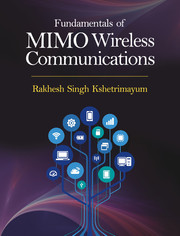Book contents
- Frontmatter
- Dedication
- Contents
- Figures
- Tables
- Preface
- Acknowledgments
- Abbreviations
- 1 Introduction to MIMO Systems
- 2 Classical and Generalized Fading Distributions
- 3 Analytical MIMO Channel Models
- 4 Power Allocation in MIMO Systems
- 5 Channel Capacity of Simplified MIMO Channels
- 6 MIMO Channel Capacity
- 7 Introduction to Space-Time Codes
- 8 Space-Time Block and Trellis Codes
- 9 Introduction to MIMO Detection
- 10 Advanced MIMO Detection Techniques
- 11 Antenna Selection and Spatial Modulation
- 12 Advanced Topics in MIMO Wireless Communications
- Appendix A Matrices
- Appendix B MGF of Hermitian Quadratic Form in Complex Gaussian Variate
- Appendix C Basics of Information Theory
- Appendix D Basics of Convolutional Codes
- Appendix E Basics of Turbo Codes
- Appendix F Algebraic Structures
- Appendix G An Introduction to Game Theory
- Index
Appendix G - An Introduction to Game Theory
Published online by Cambridge University Press: 23 July 2017
- Frontmatter
- Dedication
- Contents
- Figures
- Tables
- Preface
- Acknowledgments
- Abbreviations
- 1 Introduction to MIMO Systems
- 2 Classical and Generalized Fading Distributions
- 3 Analytical MIMO Channel Models
- 4 Power Allocation in MIMO Systems
- 5 Channel Capacity of Simplified MIMO Channels
- 6 MIMO Channel Capacity
- 7 Introduction to Space-Time Codes
- 8 Space-Time Block and Trellis Codes
- 9 Introduction to MIMO Detection
- 10 Advanced MIMO Detection Techniques
- 11 Antenna Selection and Spatial Modulation
- 12 Advanced Topics in MIMO Wireless Communications
- Appendix A Matrices
- Appendix B MGF of Hermitian Quadratic Form in Complex Gaussian Variate
- Appendix C Basics of Information Theory
- Appendix D Basics of Convolutional Codes
- Appendix E Basics of Turbo Codes
- Appendix F Algebraic Structures
- Appendix G An Introduction to Game Theory
- Index
Summary
Introduction
Game theory presents a formal analysis of interaction among a group of players in a game. In game theory, the action of player directly affects the other players. There are two types of games:
(a) Cooperative game: Player form alliance to bring the result of the game in his/her favour.
(b) Non-cooperative game: Optimal strategy for such game is that leads to Nash equilibrium, a term coined after the Nobel Laureate John Nash. Any player cannot gain from varying un-alterably his/her strategy if the strategy of all other players is fixed. An action profile is a vector of player's actions. A Nash equilibrium is an action profile in which each action is the best response to the actions of all the other players. Nash equilibrium is a stable operating or equilibrium point. It means that there is no payoff for any player in a finite game to vary strategy when all the other players pursue the equilibrium policy. The learning process can be cast as a repeated stochastic game (i.e., recast version of a one-shot game). Every player gets or knows the past behavior of the other players, which may influence the present decision to be made. The job of a player is to choose the best mixed strategy, having the knowledge of mixed strategies of all other players in the game. The mixed strategy of a player is a RV whose values are the pure strategies of that player.
An example from wireless sensor network:
For instance, in wireless sensor network, a game needs three components (S. K. Das et al., 2004):
(a) Players (sensor nodes in the network)
(b) Strategy (criteria for selection of actions of players)
(c) Utility (payoff) function is the performance metric.
Let us assume a packet is sent from a source node (SN) to a destination node (DN) through an intermediate node (IN). IN may forward the packet to the DN by using the following criteria:
(a) Reputation: Have IN and DN made enough reputation to trust and co-operate each other to forward the packet?
(b) Distance: The farther are the two nodes, the more they don't trust each other.
(c) Traffic: Have IN and DN a joint operation history? Can they trust each other?
- Type
- Chapter
- Information
- Fundamentals of MIMO Wireless Communications , pp. 342 - 346Publisher: Cambridge University PressPrint publication year: 2017



